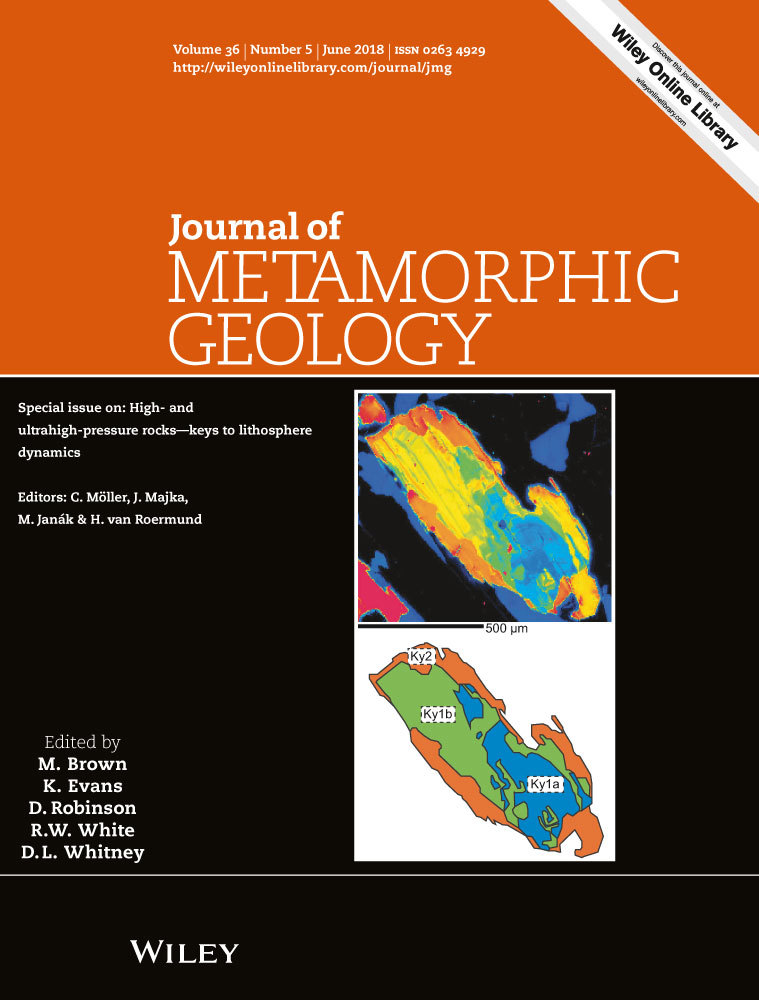Tectonic erosion related to continental subduction: An example from the eastern North Qaidam Mountains, NW China
Abstract
Tectonic erosion has been commonly recognized in oceanic subduction zones, but evidence of tectonic erosion related to continental subduction is rarely reported. In this contribution, we suggest a tectonic erosion process along the North Qaidam Mountains of NW China during the Early Palaeozoic continental subduction. To the north of the North Qaidam ultra-high pressure (UHP) metamorphic belt, the microcontinental Oulongbuluke Block (OB) is characterized by Precambrian metamorphic basement. New and existing zircon U–Pb data show that the OB underwent Early Palaeoproterozoic (2.4–2.3 Ga) magmatism and Late Palaeoproterozoic (c. 1.9 Ga) high-grade metamorphic and anatectic events. The North Qaidam UHP metamorphic belt has been considered to result from the northward subduction of the Qaidam continental block consisting mainly of Meso-Neoproterozoic orthogneiss and paragneiss. However, our new data show some gneisses enclosing eclogites in the eastern North Qaidam UHP metamorphic belt (Dulan UHP metamorphic unit) experienced 2.4–2.3 Ga magmatism and 1.9–1.8 Ga metamorphism, similar to those of the OB, prior to Early Palaeozoic UHP metamorphism. These data suggest that tectonic erosion occurred during north-dipping subduction: the Precambrian basement from the upper plate (OB) was transported in the subduction zone to more than 80 km depth, resulting in UHP metamorphism related to Early Palaeozoic continental subduction prior to their exhumation.
1 INTRODUCTION
The process of subduction erosion (tectonic erosion) that occurs in some convergent margins was postulated shortly following the introduction of plate tectonic theory (e.g. Rutland, 1971; Scholl, Christensen, von Huene, & Marlow, 1970). Parts of the upper plate are detached by subduction forces and carried down into the subduction channel, and therefore can explain crustal loss through tectonic processes along convergent margins (Muruachi & Ludwig, 1980; Scholl, von Huene, Vallier, & Howell, 1980; Von Huene & Ranero, 2003; Von Huene & Scholl, 1991). Tectonic recycling of crust back into the mantle is considered an important process associated with the subduction factory. It has been widely recognized at convergent plate boundaries, for example, the Late Cretaceous–Early Tertiary western North America and the Cenozoic South America subduction zones, where upper plate materials containing continental detritus were buried tectonically during oceanic subduction (Barth & Schneiderman, 1996; Clift & Hartley, 2007; Clift & Vannucchi, 2004; Hervé & Fanning, 2003; Ranero & von Huene, 2000; Vannucchi, Remitti, & Bettelli, 2008; Von Huene & Scholl, 1991). However, up to now, tectonic erosion has been mainly recognized in oceanic subduction zones, whereas tectonic erosion related to the process of continental subduction has been rarely reported (Yin et al., 2007).
In the past 20 years, a conspicuous geological discovery has been the recognition of the ultra high pressure (UHP) metamorphic belt along the North Qaidam Mountains in northern Tibet (Song, Niu, Su, Zhang, & Zhang, 2014; Yang et al., 2002; Zhang, Yu, & Mattinson, 2017 and references therein). The predominant rock types in the North Qaidam UHP metamorphic belt are orthogneisses and paragneisses, which were previously considered to be derived from Late Mesoproterozoic–Early Neoproterozic (1,030–890 Ma) granite and from Mesoproterozoic sedimentary rocks, respectively (Mattinson, Wooden, Liou, Bird, & Wu, 2006a; Song, Su, Li, Niu, & Zhang, 2012; Wan, Zhang, Yang, & Xu, 2006; Yu et al., 2013; Zhang, Mattinson, Meng, Wan, & Tung, 2008; Zhang, Roermund, Zhang, & Spiers, 2012; Zhang et al., 2017). Many authors suggested that the North Qaidam UHP metamorphic belt resulted from continental subduction, and the predominant continental materials in the belt are the product of the northward subduction of the Qaidam block (Song et al., 2006; Yang et al., 2002; Zhang et al., 2016, 2017). However, some authors deduced that the North Qaidam UHP metamorphic rocks are derived from either oceanic mélange or pieces of continental margin tectonically incorporated into an oceanic subduction channel (Yin et al., 2007 and references therein). In this contribution, we report newly recognized Palaeoproterozoic gneisses enclosing eclogites from the Dulan Area, eastern North Qaidam UHP metamorphic belt, and document their similarity to Palaeoproterozoic rocks in the Oulongbuluke microcontinent block to the north of the Dulan UHP unit. Based on the geological, petrological, zircon U–Pb dating and Hf isotopic data of gneisses from both the Dulan UHP metamorphic unit and the Oulongbuluke Block (OB), we suggest that Palaeoproterozoic gneisses and enclosing eclogites in the Dulan UHP unit were derived from the OB by tectonic erosion during Early Palaeozoic continental subduction.
2 GEOLOGICAL BACKGROUND
The North Qaidam Mountains are in the area between the North Qaidam Fault and Zongwulong Fault (Figures 1 and 2). It is bounded by the Qaidam Basin to the southwest, the Altyn Tagh Fault to the northwest and the Qilian block (QLB) to the northeast. Along the North Qaidam Mountains, two terranes have been recognized. They are the North Qaidam (NQM) UHP metamorphic belt and the OB, which is separated by a fault (Figure 1).
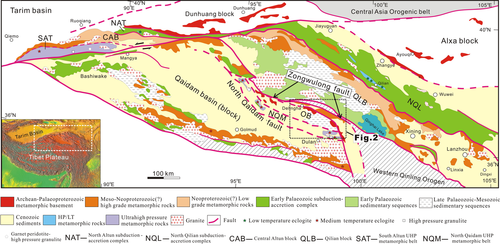
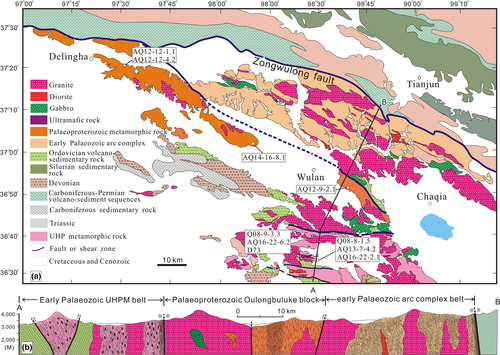
Southwest of the NQM, the Qaidam Basin is a Cenozoic sedimentary basin juxtaposed by a series of north-dipping thrusts below the North Qaidam UHP metamorphic belt along its northern edge (Wu et al., 2016; Yin et al., 2007). The previous studies suggested that the Qaidam Basin is underlain mainly by Precambrian (Meoproterozoic–Neoproterozoic) crystalline basement (Qaidam block; Bureau of Geology and Mineral Resources Qinghai Province (BGMQ), 1991; Wang & Coward, 1990), which was recently verified by the investigation on the basement rocks of the Qaidam Basin collected from drilling wells (Cheng et al., 2017).
Northeast of the NQM, the Qilian block comprises mainly Neoproterozoic–Palaeozoic sedimentary rocks deposited over Precambrian granitic gneiss, pelitic gneiss, schist and marble, and intruded by Early Palaeozoic granites (Wan, Xu, Yang, & Zhang, 2001; Wan et al., 2006 and references therein). Further north, an Early Palaeozoic, Pacific-type suture characterized by blueschist, eclogite and ophiolites extends between the Alxa block and the Qilian block (Song et al., 2006; Zhang, Meng, & Wan, 2007; Figure 1).
2.1 North Qaidam UHP metamorphic belt
The basement of the North Qaidam UHP metamorphic belt is mainly composed of orthogneiss, paragneiss, with lesser amphibolite, mafic granulite, marble, and locally eclogite or garnet-peridotite lenses, similar to most continental-type UHP terranes worldwide. They are thrust over, or exhibit a detachment contact with the Early Palaeozoic volcanic sedimentary rocks of the Tanjianshan Group, and are intruded by Silurian granites (Mattinson, Menold, Zhang, & Bird, 2007; Song, Yang, Xu, Liou, & Shi, 2003; Song et al., 2006, 2014; Yang et al., 2002; Yin et al., 2007; Zhang, Mattinson, et al., 2008; Zhang, Song, Zhang, & Niu, 2008; Zhang et al., 2005, 2017). The magmatic protolith ages of most orthogneisses from the NQM UHP metamorphic belt are Late Mesoproterozoic–Early Neoproterozoic (1,030–890 Ma; Mattinson, Wooden, Liou, Bird, & Wu, 2006b; Song et al., 2012; Wan et al., 2001, 2006; Yu et al., 2013; Zhang, Mattinson, et al., 2008; Zhang et al., 2012). Some paragneisses record an almost concurrent metamorphism at 945–895 Ma (Yu et al., 2013; Zhang, Mattinson, et al., 2008; Zhang et al., 2012). However, a few gneisses in the Dulan area, eastern NQM UHP metamorphic belt have Palaeoproterozoic protolith ages of (see below), suggesting that they may have a different origin. Most eclogites of the NQM UHP metamorphic belt have protolith ages ranging from 850 to 750 Ma (Xu et al., 2016; Zhang, Mattinson, Yu, Li, & Meng, 2010; Zhang, Mattinson, et al., 2008; Zhang et al., 2005, 2017 and references therein). Minor eclogite blocks from the Dulan UHP terrane yielded Cambrian protolith ages (c. 516 Ma; Zhang, Song, et al., 2008; Zhang et al., 2016), and were interpreted as part of an ophiolite sequence (Zhang, Song, et al., 2008), implying possible preservation from oceanic subduction that preceded continental subduction and collision (Song et al., 2006, 2014; Zhang, Song, et al., 2008; Zhang et al., 2016).
A large number of zircon U–Pb ages have been reported for NQM UHP metamorphic rocks. Most SHRIMP and LA-ICPMS U–Pb data yield ages ranging from 460 to 420 Ma. Combining these ages with petrological and geochemical data, Song et al. (2014) suggested an earlier oceanic subduction event (460–440 Ma), followed by a continental subduction event (440–420 Ma). Although an earlier oceanic subduction or subduction of continent–ocean transition zone cannot be excluded (Song et al., 2006; Yin et al., 2007; Zhang, Zhang, & Christy, 2013; Zhang et al., 2016), most published data show that eclogite and host gneisses (continental material) have a similar metamorphic age range. We, therefore, prefer to explain that the NQM may represent diachronous or protracted (prolonged) (U)HP metamorphism during early continental subduction and collision (e.g. Mattinson et al., 2006b; Zhang et al., 2010, 2017.
2.2 Oulongbuluke Block
The OB forms a narrow, WNW-ESE oriented belt in the Dakendaban–Quanji Mountain–Delingha–Wulan area (Figure 1). It is separated from the Qaidam block by the NQM UHP metamorphic belt to the south, and from the Qilian block by the Zongwulong Fault (tectonic belt) to the north (Figure 1). The basement of the OB includes the Delingha Complex and Dakendaban Group (Lu, Li, Zhang, & Niu, 2008). They are overlain unconformably by low-grade metamorphosed Wandonggou Group, unmetamorphosed Neoproterozoic Quanji Group and Lower Palaeozoic Oulongbuluke Group (Chen, Zhang, Sun, Wang, & Kusky, 2012; Chen et al., 2013; Lu et al., 2008). The Delingha Complex is mainly composed of amphibolite, monzogranitic gneiss and migmatite. Amphibolite (locally mafic granulite) is exposed as enclaves at various scales (Gong et al., 2012; Lu et al., 2008). The granitic gneisses have been dated at 2.40–2.20 Ga (Gong et al., 2012; Lu et al., 2008). The Dakendaban Group mainly comprises high-grade metamorphic supercrustal rocks including paragneiss, micaschist, quartzite and marble (Chen et al., 2013). Published geochronological data suggest that both the Dakendaban Group and the Delingha Complex record a 1.95–1.80 Ga tectonothermal event (Chen et al., 2013; Gong et al., 2012; Liao et al., 2014; Yu et al., 2017).
In addition, an Early Palaeozoic arc complex belt, which mainly consists of high-grade metamorphic rocks and spatially associated mafic and granitic plutons, is newly recognized in northern part of the OB (Figure 2). It was previously considered as part of the Palaeoproterozoic metamorphic basement. Recently, new data show that this unit experienced Early Palaeozoic (500–460 Ma) low-P/high-T metamorphism and associated magmatism (Li et al., 2015; J. Zhang et al., unpublished data). This also suggests an earlier oceanic subduction prior to continental subduction along the North Qaidam Mountains (see discussion below).
3 SAMPLE DESCRIPTIONS
In this study, more than 100 samples from the eastern sector of the North Qaidam UHP metamorphic belt (Dulan UHP metamorphic unit) and the eastern OB (Delingha–Wulan area) were collected. Ten representative samples were used for zircon U-Pb and Hf isotopic analyses. Their locations are shown on Figure 2.
3.1 Oulongbuluke Block
Three felsic orthogneisses (AQ12-12-1.1, AQ12-12-4.2 and AQ14-16-8.1) and one paragneiss (AQ12-9-2.1) from OB were sampled for zircon U–Pb dating (Figure 2). These felsic orthogneisses display clear gneissic structures and preserve locally migmatitic textures characterized by quartzofeldspathic leucosomes and dark melanosomes with a higher concentration of biotite (Figure 3a). The amphibolite (partly mafic granulite) can be observed as lenses or interlayers within the felsic gneisses (Figure 3a). The homogenous felsic orthogneisses consist of K-feldspar (~35%), plagioclase (~25%), quartz (~25%) and biotite (8%–12%), with minor apatite, titanite, monazite and zircon (Figure 4a,b). Feldspar shows a certain degree of sericitization, and the biotite is partially replaced by chlorite. The quartz shows dynamic recrystallization related to ductile deformation.
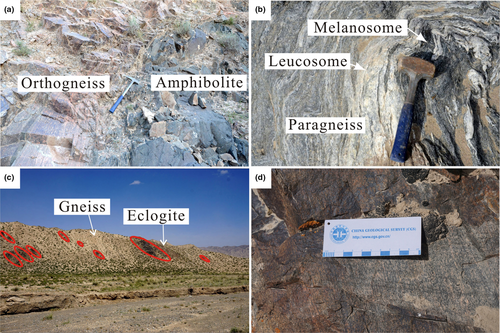

Migmatitic paragneiss exhibits a mixture of light-coloured quartzofeldspathic leucosomes interpreted to represent the former sites of melt segregation, and grey-coloured palaeosomes and dark-coloured melanosomes which are interpreted to represent the residuum from which melt was extracted (Figure 3b). The leucosomes generally occur as thin layers parallel to the foliation in the gneiss, and are mainly composed of feldspar and quartz, with very minor biotite, titanite, apatite and zircon. Leucosome layers are locally folded by tight to open folds on the centimetre to metre scale. Sample AQ12-9-2.1 is sourced from grey-coloured palaeosomes with thin leucosome layers. It is mainly composed of feldspar (K-feldspar+plagioclase, 30%–35%), quartz (40%–45%), biotite (~10%) and epidote (~10%), with zircon, titanite and monazite as accessory minerals (Figure 4b,c).
3.2 Dulan UHP metamorphic unit
Four samples of felsic gneiss (Q08-8-1.5, Q08-9-3.3, AQ13-7-4.2 and D73) and two eclogite samples (AQ16-22-2.1 and AQ16-22-6.2) were collected from the south of the Shaliu River and north of the Aercituo Mountain. These felsic gneisses enclose eclogite lenses or boudins from 1 to 10 m in width (Figure 3c,d and Figure S1). Eclogite lenses commonly are rimmed by foliated amphibolites parallel to the foliation of the enclosing gneisses. The four gneiss samples have similar texture and mineral composition. They display a porphyroblastic texture and weak gneissic structure. Their mineral assemblage is quartz+plagioclase+K-feldspar+garnet+biotite+amphibole, with minor titanite, epidote and zircon (Figure 4c). This mineral assemblage suggests an amphibolite facies metamorphism related to retrogression. No clear HP-UHP evidence is recognized although some titanite grains contain rutile inclusions, possibly representing high-P metamorphic relicts (Figure 4c).
The mineral assemblage of eclogites (AQ16-22-2.1 and AQ16-22-6.2) is garnet+omphacite+rutile+quartz±phengite (Figure 4d). Amphibole+plagioclase symplectite around omphacite records minor amphibolite-facies retrogression. Garnet–clinopyroxene–phengite thermobarometry yields a P–T condition ~700°C and 2.8 GPa (J. Zhang et al., unpublished data), falling in the coesite stability field although relict coesite has not been observed.
4 ZIRCON U–Pb AND Hf ISOTOPIC ANALYSES
4.1 Analytical procedures
The zircon U–Pb dating of sample D73 was carried out on the Stanford/USGS SHRIMP-RG. The zircon U–Pb and Hf isotopic analysis was carried out using laser ablation sampling and multiple collector inductively coupled plasma mass spectrometry at the Tianjin Institute of Geology and Mineral Resources. Analytical procedures are presented in Appendix S1. The detailed data are shown in Tables S1–S3.
4.2 U–Pb dating results
4.2.1 Oulongbuluke Block
Felsic orthogneisses
Zircon grains from felsic orthogneisses are 150–300 μm long and show irregular or prismatic morphologies. In the CL images, some crystals (sample AQ12-12-1.1) are characterized by irregular inherited zircon cores, oscillatory zoning inner rims, and structureless and CL-dark outer rims (Figure 5). The inherited zircon cores from AQ12-12-1.1 yield 207Pb/206Pb ages ranging from 2,937 ± 16 Ma to 2,443 ± 15 Ma. The oscillatory-zoned inner rims gave 207Pb/206Pb ages between 2,405 ± 16 Ma and 2,354 ± 15 Ma, combining to a weighted mean age at 2,378 ± 12 Ma (n = 11, MSWD = 1.3), which we interpret as the magmatic crystallization age of the protolith of the felsic orthogneiss. Five analyses of structureless outer rims gave 207Pb/206Pb ages between 1,935 ± 19 and 1,888 ± 20 Ma, combining a weighted mean age of 1,914 ± 16 Ma (Figure 6), which we interpret to reflect Late Palaeoproterozoic metamorphism.
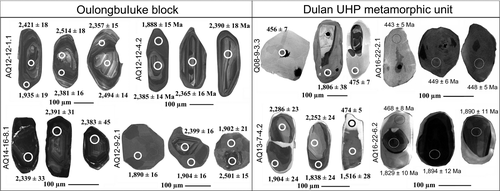
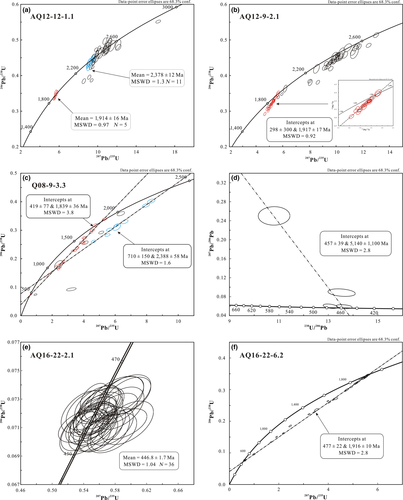
Zircon grains from felsic orthogneisses, AQ12-12-4.2 and AQ14-16-8.1, show oscillatory-zoned domains surrounded by structureless rims with varying width (Figure S2). The analyses from oscillatory-zoned domains yield upper intercept ages of 2,364 ± 10 Ma (MSWD = 1.4) and 2,390 ± 9 Ma (MSWD = 0.62) for AQ12-12-4.2 and AQ14-16-8.1, respectively (Figure S3), which are interpreted as the magmatic crystallization age of the protolith. Seven analyses from structureless zircon rims of AQ12-12-4.2 yield a weighted mean age of 1,889 ± 13 Ma (MSWD = 0.23), and one analysis from a zircon rim of AQ14-16-8.1 gives a 207Pb/206Pb age of 1,886 ± 39 Ma (Table S1), which are interpreted as timing of a metamorphic and anatectic event.
Migmatitic paragneiss
Zircon grains from migmatitic paragneiss AQ12-9-2.1 are 100–250 μm in diameter and show oval and nearly spherical morphologies. CL images reveal that most grains contain CL-bright grey and oscillatory-zoned cores, and CL-grey and structureless or fir-tree zoned rims (Figure 5). A few zircon grains do not have cores but consist entirely of CL-grey grains with patchy or fir-tree patterns (Figure 5 and Figure S2), similar to those of the rims surrounding the cores. The 37 cores analysed yield 207Pb/206Pb ages ranging from 2,708 ± 15 Ma to 2,318 ± 19 Ma, which are interpreted as ages of detrital zircon from the sedimentary protolith of the paragneiss. The 24 analyses from zircon rims yield an upper intercept age of 1,917 ± 17 Ma (MSWD = 0.92; Figure 6).
4.2.2 Dulan UHP metamorphic unit
Felsic gneisses
Zircon grains from four felsic gneiss samples show oval and irregular morphologies with lengths of 150–400 μm. The CL images reveal that most grains have core–rim structures. Some grains contain CL-bright outer rims (Figure 5). Two analyses from CL-bright outer rims of sample AQ13-7-4.2 yield 206Pb/238U ages of 474 ± 5 and 502 ± 6 Ma. Four analyses from the entirely CL-grey grains and outer rims from sample Q08-9-3.3 give 206Pb/238U ages from 571 ± 21 to 456 ± 7 Ma, combining to an intercept age at 457 ± 39 Ma on a Tera–Wasserburg diagram (Figure 6d). Excluding these analyses from zircon outer rims, the remaining analyses from four samples can be divided into two clusters: The older clusters are mainly from the zircon cores and yield Early Palaeoproterozoic ages (2,329 ± 33, 2,307 ± 32, 2,388 ± 58 and 2,364 ± 20 Ma for samples AQ13-7-4.2, Q08-8-1.5, Q08-9-3.3 and D73 respectively). The younger clusters are from the zircon inner rims and yield Late Palaeoproterozoic ages (1,882 ± 20, 1,833 ± 19, 1,839 ± 36 and 1,849 ± 17 Ma respectively).
Eclogites
Zircon grains from eclogites are 80–160 μm in diameter and show near-spherical or short prismatic morphologies. The CL images reveal that some grains of sample AQ16-22-6.2 contain CL-dark cores surrounded by CL-bright rims with little internal structure (Figure 5). The zircon from sample AQ16-22-2.1 does not have cores but consists entirely of structureless CL-bright zircon. The 36 concordant analyses from sample AQ16-22-2.1 gave 206Pb/238U ages between 456 ± 6 and 438 ± 4 Ma (Table S1), combining a weighted mean age of 446.8 ± 1.7 Ma (MSWD = 1.04; Figure 6e). Six zircon rims of sample AQ16-22-6.2 gave an Early Palaeozoic age between 486 ± 6 and 468 ± 8 Ma (Table S1). The remaining analyses on the cores gave Palaeoproterozoic 207Pb/206Pb ages. Combining all the data yields a concordia upper intercept age of 1,916 ± 10 Ma and a lower intercept age of 477 ± 22 Ma (MSWD = 2.8; Figure 6f).
4.3 Hf isotopic results
4.3.1 Oulongbuluke Block
Of the 77 Hf isotope analyses obtained for orthogneiss samples AQ12-12-1.1 and AQ12-12-4.2, 69 of those from inherited cores and magmatic rims with oscillatory zoning have 176Hf/177Hf ratios ranging from 0.281210 to 0.281564 (mainly between 0.281300 and 0.281400; Table S3). Their age-corrected εHf(t) values are between −8.47 and 8.52 with two-stage model ages (TDM2) ranging from 2.91 to 2.55 Ga (Figure 7; Table S3). Eight analyses on c. 1.9 Ga outer rims yield 176Hf/177Hf ratios of 0.281371 and 0.281481, age-corrected εHf(t) values of −4.10 and −7.32, with TDM2 between 2.77 and 2.59 Ga. The 176Hf/177Hf ratios of this metamorphic zircon overlap those of the inherited and magmatic zircon.
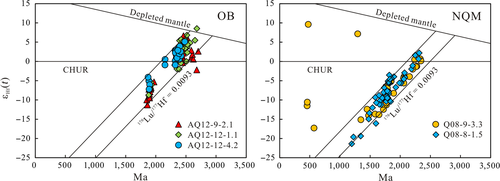
Of the 40 Hf isotope analyses obtained for migmatitic paragneiss AQ12-9-2.1, 23 analyses from detrital cores have 176Hf/177Hf ratios ranging from 0.281080 to 0.281431 (Table S3). Their age-corrected εHf(t) value is between −2.17 and 6.68, corresponding to TDM2 values between 3.16 and 2.54 Ga. Seventeen analyses from metamorphic rims have 176Hf/177Hf ratios ranging from 0.281296 to 0.281413, overlapping those from the detrital zircon cores. Their age-corrected εHf(t) values are between −5.31 and −11.30, and corresponding TDM2 between 2.94 and 2.70 Ga.
4.3.2 Dulan UHP metamorphic unit
Although most of the zircon grains from the felsic gneisses Q08-8-1.5 and Q08-9-3.3 yielded discordant ages and experienced a distinct loss of radiogenetic Pb, the 176Lu/177Hf and 176Hf/177Hf (t) values do not show any clear trends accompanying the increasing age discordance. Of 80 Hf isotope analyses obtained for samples Q08-8-1.5 and Q08-9-3.3, four analyses from CL-bright outer rims, which combine an intercept age at 457 ± 39 Ma on a Tera–Wasserburg diagram, have 176Hf/177Hf ratios between 0.281929 and 0.282768 (Table S3), significantly higher than the other analyses. Excluding these four analyses, the remaining 76 analyses yield 176Hf/177Hf ratios ranging from 0.281325 to 0.281535, and show no significant difference between c. 2.3 Ga cores and c. 1.85 Ga rims. Their age-corrected εHf(t) values are between −16.09 and 0.63, corresponding to TDM2 between 2.97 and 2.52 Ga.
5 DISCUSSION
5.1 Palaeoproterozoic magmatic and metamorphic ages of the OB
In this study, three orthogneisses from the Delingha Complex of the OB yield ages of 2,364 ± 10 Ma (AQ12-12-4.2), 2,378 ± 12 Ma (AQ12-12-1.1) and 2,390 ± 9 Ma (AQ14-16-8.1) from zircon cores which exhibit clear oscillatory zoning with high Th and U contents, and high Th/U ratios. These features suggest that these zircon domains are magmatic in origin and thus 2.39–2.36 Ga represents the magmatic protolith age of the orthogneisses. Similar Early Palaeoproterozoic magmatic ages (from 2.4 to 2.3 Ga) have been commonly reported in the Delingha Complex of the OB (Figure S4; Gong et al., 2012; Yu et al., 2017 and references therein). Two orthogneisses give weighted mean ages of 1,914 ± 16 Ma (AQ12-12-1.1) and 1,889 ± 13 Ma (AQ11-12-4.2), one granitic orthogneiss (AQ14-16-8.1) gives a 207Pb/206Pb age of 1,886 ± 39 Ma, and one migmatitic paragneiss (AQ12-9-2.1) yields an upper intercept age of 1,917 ± 17 Ma. Most of these data were obtained from CL structureless rims, similar to typical metamorphic zircon. A few analyses from oscillatory-zoned rims possibly imply an anatectic origin. We thus interpret the c. 1.9 Ga as the age of metamorphism and possible anatexis. Previous studies gave similar Late Palaeoproterozoic metamorphic ages ranging from 1.95 to 1.80 Ga (Chen et al., 2013; Yu et al., 2017 and references therein, also see Figure S4). Chen et al. (2013) suggested that the OB underwent multiple Late Palaeoproterozoic metamorphic events: medium-P/T type upper amphibolite facies metamorphic event at 1.96–1.90 Ga; low-P/T amphibolite facies metamorphism at c. 1.85–1.82 Ga and a subsequent medium-P/T metamorphism at c. 1.82–1.80 Ga. SHRIMP U–Pb analyses of one mafic granulite (enclosed in orthogneiss AQ12-12-4.2) also give multiple metamorphic ages at c. 1.91, 1.86 and 1.83 Ga, which are interpreted as granulite facies metamorphic timing and subsequent amphibolite facies overprinting ages (Chen et al., 2013). However, a detailed discussion of multiple Palaeoproterozoic metamorphic events is outside the scope of this paper. Generally, the present data provide unambiguous evidence that the OB underwent Early Palaeoproterozoic magmatism and subsequently Late Palaeoproterozoic high-grade metamorphic and anatectic event(s).
5.2 Palaeoproterozoic rocks in the Dulan UHP metamorphic unit: slices from the OB?
Although Palaeoproterozoic and Archean ages have been reported from inherited or detrital zircon from orthogneisses and paragneisses in the NQM UHP metamorphic belt as well as in the Qaidam block (e.g. Mattinson, Wooden, Zhang, & Bird, 2009; Yu et al., 2013), metamorphic rocks with Palaeoproterozoic protolith ages have not previously been recognized. In this study, four orthogneiss samples from the Dulan UHP metamorphic unit give U–Pb ages of 2,307 ± 32, 2,388 ± 58, 2,329 ± 33 and 2,364 ± 20 Ma from analyses on zircon cores with oscillatory zoning. Combined with petrographic observations, we interpret that 2.39–2.31 Ga represents the magmatic crystallization age of the orthogneiss protoliths, similar to those from the OB orthogneisses. The zircon rims (inner rims) from four gneiss samples yield ages of 1,833 ± 19, 1,839 ± 36, 1,882 ± 20 and 1,849 ± 17 Ma. These ages are obtained mainly from CL structureless rims and we thus interpret them to record Late Palaeoproterozoic metamorphism, consistent with the age of Late Palaeoproterozoic metamorphism recorded in the OB. In addition, the analyses on CL structureless zircon cores from one eclogite sample enclosed within gneiss give an age of 1,916 ± 10 Ma, similar to the age obtained from metamorphic mafic rocks enclosed within orthogneisses in the OB (Yu et al., 2017). These data demonstrate that some gneisses and enclosed mafic rocks from both the NQM UHP metamorphic belt and Oulongbukuke experienced similar Early Palaeoproterozoic magmatism and Late Palaeoproterozoic metamorphism (Figure S4). In addition, the Palaeoproterozoic magmatic and metamorphic zircon from the two terranes have consistent Hf isotopic features (Figure 7). Despite variable Pb-loss, Palaeoproterozoic zircon of the gneisses from both units shows similar Hf isotopic evolution patterns and correspondingly consistent Hf model ages (Figure 7). Therefore, we suggest that these rocks with Palaeoproterozoic protolith age in the NQM UHP metamorphic belt may be derived from the Palaeoproterozoic metamorphic basement of the OB rather than from the Qaidam block. Up to now, no Palaeoproterozoic magmatic and metamorphic rocks have been reported in the Qaidam block although zircon with Palaeoproterozoic ages has been observed as detrital or inherited grains in Neoproterozoic–Palaeozoic metasedimentary rocks or magmatic rocks from the basement of the Qaidam Basin (e.g. Cheng et al., 2017).
5.3 Tectonic models for Early Palaeozoic NQM UHP metamorphic belt
Several contrasting models have been proposed to explain the formation and geodynamic evolution for the NQM UHP metamorphic belt (Song et al., 2006, 2014; Yang et al., 2002; Yin et al., 2007; Zhang et al., 2017). The debates concern continental v. oceanic subduction and the subduction polarity. Yang et al. (2002) explained the NQM UHP metamorphic belt as an Early Palaeozoic suture, which resulted from the north-dipping subduction of the Qaidam block. Song et al. (2006) proposed a single, north-dipping subduction model to incorporate both the North Qilian oceanic subduction belt and NQM continental subduction belt. This model implied that the NQM UHP metamorphic belt is not a suture, and the NQM UHP rocks travelled ~350 km after originating as oceanic crust from the northern margin of the Qilian–Qaidam block basement, and were then tectonically emplaced within the continental crust of the coherent Qaidam–Qilian block (see review by Song et al., 2014). However, in this model it is difficult to explain the Early Palaeozoic arc magmatic and metamorphic events in the northern part of the North Qadiam Mountains (Li et al., 2015; Shi, Wu, & Yang, 2004). Yin et al. (2007) proposed a “diapiric flow” model, in which the NQM UHP metamorphic eclogites originated from south-dipping subducted palaeo-Qilian oceanic crust via diapiric flow across the mantle wedge. Subduction of continental–oceanic transition zone sediments was invoked to explain the occurrence of the continental UHPM materials. However, in this model it is difficult to interpret the dominant continental material in the NQM UHP metamorphic belt, which mainly consists of Late Mesoproterozoic–Early Neoproterozoic gneisses, similar to Precambrian crystalline basement of the Qaidam block.
Based on the existing and our new data, we explain the NQM UHP metamorphic belt as a result of north-dipping continental subduction of the Qaidam block following earlier oceanic subduction (Zhang et al., 2016, 2017; and references therein). The earlier oceanic subduction along the North Qaidam Mountains is also supported by a newly recognized arc magmatic–metamorphic belt in the northern part of the North Qaidam Mountains (Figure 2). This arc unit is proposed to be related to oceanic subduction that preceded continental subduction (Li et al., 2015). The spatial overlapping of UHP rocks and arc sequences (Tanjianshan Group) along the NQD can be related to Mesozoic–Cenozoic deformation (Yu et al., 2017; and references therein).
5.4 Tectonic erosion related to continental subduction
Tectonic erosion can be classified into two distinct processes, that is, frontal erosion and basal erosion (Vannucchi et al., 2008; Von Huene & Scholl, 1991). The former can tectonically erode pre-existing accretionary wedge/slope sediments. On the other hand, the latter works at much deeper levels where basement material from the upper plate is tectonically removed into the subduction channel (e.g. Clift & Hartley, 2007; Clift & Vannucchi, 2004).
As mentioned above, northward subduction of the Qaidam block is preferred to explain the formation of the continental-type UHP metamorphic rocks along the North Qaidam Mountains. If this subduction geometry is correct, gneiss and enclosed eclogite with Palaeoproterozoic protolith ages in the NQM UHP metamorphic belt would be derived from the upper plate (OB) rather than the lower plate (Qaidam block). As mentioned before, the Qaidam block mainly consists of Meoproterozoic–Neoproterozoic crystalline basement, and no Palaeoproterozoic rocks have been reported. LA-ICMPS and SHRIMP U–Pb dating on the metamorphic rims of zircon from these gneisses and eclogites yields an Early Palaeozoic age. These data suggest that the Palaeoproterozoic gneisses and enclosed eclogites underwent a common Early Palaeozoic UHP metamorphism; the scarcity of (U)HP assemblages in these gneisses might be explained by the more extensive retrograde recrystallization, compared with the enclosed eclogites.
Based on the discussion above, we propose a tectonic erosion model: When the Qaidam block subducted towards the north under the OB during the Early Palaeozoic, slices of Palaeoproterozoic basement from the upper plate (OB) were tectonically buried to more than 80 km depth in the subduction channel, and experienced UHP metamorphism during the Early Palaeozoic continental subduction prior to their exhumation (Figure 8). This also implies that a basal erosion process occurred in the North Qaidam Mountains during the Early Palaeozoic. However, given the lack of an accretionary complex in the eastern North Qaidam Mountains (the Dulan region), frontal erosion cannot be excluded during oceanic subduction prior to continental subduction (Yin et al., 2007).
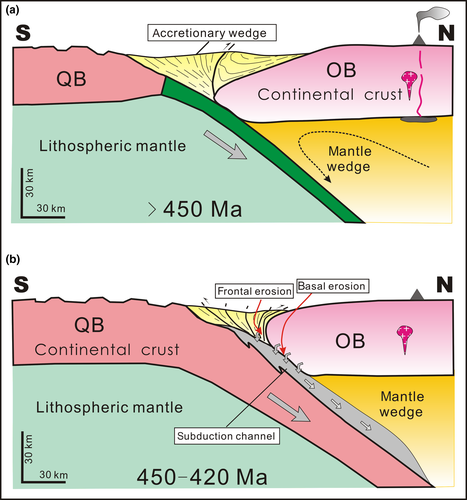
6 CONCLUSIONS
- Based on previous data and our new zircon U–Pb dating of representative gneisses, we suggest that the OB underwent Early Palaeoproterozoic magmatism (2.4–2.3 Ga) and subsequently experienced Late Palaeoproterozoic (c. 1.9 Ga) high-grade metamorphism and anatexis.
- Compared to the OB, some gneisses and enclosing eclogites in the Dulan unit of the NQM UHP metamorphic belt experienced similar Early Palaeoproterozoic magmatism and Late Palaeoproterozoic metamorphism before Early Palaeozoic UHP metamorphism. Zircon from the two terranes also shows consistent Hf isotopic features. We thus infer that these gneisses and enclosing eclogites are slices derived from the Palaeoproterozoic metamorphic basement of the OB.
- We suggest that Palaeoproterozoic basement was tectonically eroded from the upper plate (OB), buried to more than 80 km depth in the subduction channel, and metamorphosed to UHP conditions during Early Palaeozoic continental subduction prior to exhumation.
ACKNOWLEDGEMENTS
This work was financially supported by the National Natural Science Foundation of China (grant nos 41630207, 41572180), the Geological Survey Project of China (grant no. 12120115027001), and the U.S. National Science Foundation (EAR1347433, EAR0710927). Constructive comments by two anonymous reviewers are greatly appreciated. We also thank Guest Editor J. Majka and Chief Editor D. Robinson for insightful reviews and editorial work on this manuscript.



